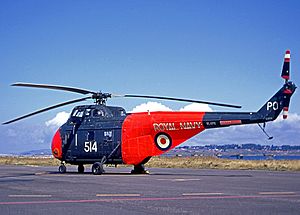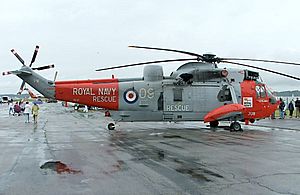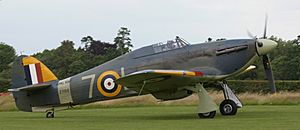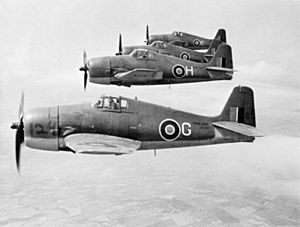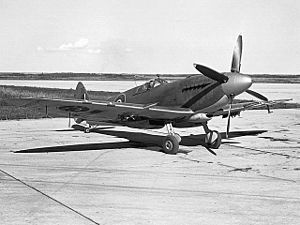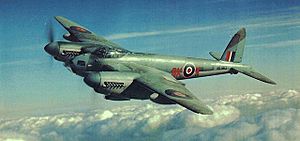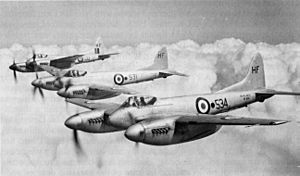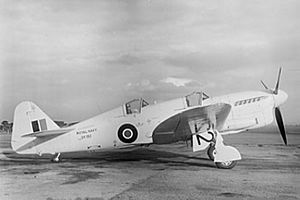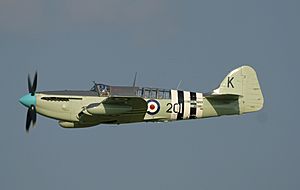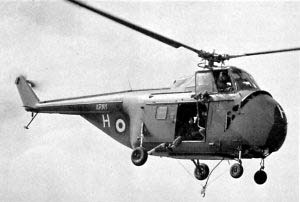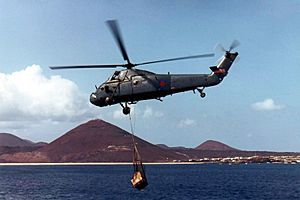771 Naval Air Squadron facts for kids
Quick facts for kids 771 Naval Air Squadron |
|
|---|---|

771 Naval Air Sqdn crest
|
|
| Active | 1939–1955 1961–1964 1967–2016 |
| Country | |
| Branch | Fleet Air Arm of the Royal Navy |
| Role | Search and Rescue Training |
| Garrison/HQ | RNAS Culdrose |
| Motto(s) | "Non Nobis Solum" (Latin: "Not unto us alone") |
| Equipment | Sea King HAR.5 |
| Commanders | |
| Commanding officer | Commander M Shepherd Royal Navy |
The 771 Naval Air Squadron was a special group of the Royal Navy's air force, called the Fleet Air Arm. It started on May 24, 1939, at a place called Lee-on-Solent. Their first job was to help the Navy by doing different training exercises. This included flying planes like the Fairey Swordfish to pull targets for other planes to shoot at. The squadron was closed down on March 22, 2016.
Contents
World War II Missions
At first, the 771 Squadron had two parts: 'X' Flight in the north and 'Y' Flight in the south. 'X' Flight soon became its own squadron, 772 Naval Air Squadron, in September 1939. The 771 Squadron then moved to RNAS Hatston and flew many different types of aircraft. These included planes like the Supermarine Walrus and Hawker Hurricane. They flew from airfields all over the UK and even abroad.
Finding the Bismarck
One of the most important things 771 Squadron did during the war was helping to find the German battleship Bismarck. This huge warship was a big threat. The commander at RNAS Hatston, Captain Henry Lockhart St John Fancourt, wanted to find and sink the Bismarck as soon as possible. His planes didn't have enough range to attack it in the harbour. He was waiting for the Royal Air Force to fly over Bergen and tell the Royal Navy when the battleship left port.
On May 22, 1941, the RAF said the weather was too bad to fly. But Captain Fancourt decided to send a crew from 771 Squadron anyway. Temporary Lieutenant Noel Ernest Goddard volunteered to fly their Martin Maryland plane. His crew included John Walker Armstrong and J. D. Milne. Commander Geoffry Alexander Rotherham, a very experienced observer, joined them as the mission leader.
Goddard flew very low over the sea, using his instruments to guide him. They found that the Bismarck had already sailed! They tried to radio this news to the RAF, but got no reply. So, Commander Rotherham decided to contact their air station directly. He also flew straight to an airfield where other planes were ready to attack.
Because of Rotherham's message, the Home Fleet (a large group of Royal Navy ships) went out to sea. They found the Bismarck and fought it in the Battle of the Denmark Straits. On September 16, 1941, the brave crew members received awards for their actions: Rotherham got the DSO, Goddard the DSC, and Armstrong the DSM.
Later War Years
In July 1942, 771 NAS moved to RNAS Twatt. There, they flew more modern aircraft and continued their important work.
After World War II
In February 1945, 771 Squadron became the first naval air squadron to use helicopters! They received the Sikorsky Hoverfly. After the war ended in Europe, the squadron moved to several different airfields. They flew many types of planes, including the Miles Martinet, Douglas Boston, and Vought Corsair. The helicopters were later moved to another squadron.
Due to military cutbacks after the war, 771 Squadron was officially closed down in August 1955. Its duties were combined with other squadrons.
Becoming a Helicopter Squadron
771 Squadron started up again in 1961. This time, their main job was to test and train with helicopters. They used helicopters like the Westland Whirlwind, Westland Dragonfly, and the Westland Wasp prototype. During this time, they invented and improved many Search and Rescue (SAR) techniques. These included refueling helicopters in the air and special ways to rescue people from cliffs.
Soon, the squadron took on the important job of Search and Rescue for the area around RNAS Portland. However, the squadron was closed again on December 1, 1964.
Focus on Search and Rescue
On June 23, 1967, the squadron reformed for a third time. Their main task was now to help with anti-submarine warfare, but they also kept their SAR duties. They used nine Whirlwind HAS.7 helicopters. In 1969, they started using the Westland Wessex helicopter, which became a long-time partner for the squadron. By 1970, Search and Rescue became 771's most important job, and it stayed that way.
The squadron moved to RNAS Culdrose in September 1974. Some of their Wessex helicopters stayed at RNAS Portland to form a new squadron, 772 Naval Air Squadron. In 1979, the Wessex HAS.1 was replaced by the more powerful Wessex HU.5. These new helicopters were involved in the rescues during the 1979 Fastnet race, a famous sailing race where many boats got into trouble.
During the Falklands Conflict in 1982, many of 771's aircraft and crew were sent to help with troop transport. After the conflict, 771 Squadron got back to its SAR duties. In 1987, they started using the Westland Sea King HAR.5 helicopter. This allowed them to perform long-range, day and night, all-weather Search and Rescue missions.
In its final years, 771 Squadron operated nine Sea King HAR.5 helicopters. These helicopters were painted in grey and red. Their main job was military Search and Rescue, but they also helped with civilian rescues. They trained pilots and observers, and helped with other tasks. One helicopter was always ready to fly within 15 minutes during the day and 45 minutes at night. This duty was kept up 24 hours a day, 365 days a year.
The squadron stopped its rescue duties on January 1, 2016, and was officially closed on March 22, 2016. Over its history, 771 Squadron saved more than 15,000 lives during over 9,000 missions.
The Ace of Clubs Symbol
The helicopters of 771 Squadron had an unofficial "Ace of Clubs" logo painted on them. The exact reason for this symbol isn't fully clear. It's thought to be similar to how some squadrons used playing card suits in the past. In the old days, squadrons sometimes had display teams. Each display aircraft would have a card suit symbol. The squadron commander would have the Ace, the second-in-command the King, and so on. This showed who was in charge.
Today, 771 Squadron doesn't assign a specific helicopter to each pilot. Instead, any pilot can fly any helicopter. So, they decided to paint only the Ace of Clubs on all their helicopters.
Heroic Rescues
771 NAS was one of the busiest Search and Rescue units in the UK. They were called out about 220 times each year. They often helped with patient transfers and hospital transfers in the West Country. This was especially true when the civilian air ambulance was busy, or when the weather was bad, at night, or if there was no good landing spot. The Sea King's winch was very useful in these situations.
Many individuals from 771 Squadron received awards for their bravery. These include 4 George Medals, 4 Air Force Crosses, 6 Queen's Gallantry Medals, and 14 Queen's Commendation for Bravery awards. Some of their most famous rescues include:
- 1979 – Fastnet Race: Lieutenant Jerry Grayson received the Air Force Cross for his role in this challenging rescue.
- 1985 – Fastnet Race: Rescue Diver POACMN L Slater received the George Medal for saving Simon Le Bon and 19 other people from the yacht Drum.
- 1989 – MV Secil Japan: Rescue Diver CPOACMN JPR Grinney received the Air Force Medal.
- 1989 – MV Murree: Rescue Divers POACMN DS Wallace and POACMN SW Wright each received the George Medal.
- 1992 – Night rescue of five crew from yacht Sine Seorra off Guernsey: LA I Chambers received the Air Force Medal.
- 2004 – Boscastle Flood rescues: Lieutenant Commander MJ Ford RN received the Air Force Cross for his actions during this major flood.
- 2007 – MSC Napoli: PO J O'Donnel received the Queen's Gallantry Medal.
- 2011 – Yacht Andriette: Sergeant A Russell RM received the George Medal for his role in this rescue.
Celebrating 60 Years of SAR
771 NAS was one of only two active units that had a dedicated Royal Navy Search and Rescue role. Because of this, they were a key part of the year-long celebration in 2013. This event marked 60 years of Royal Navy Helicopter Search and Rescue. Events took place across the country, and the Royal Navy SAR Force raised £60,000 for charity.
Aircraft Used by 771 NAS
Over its long history, 771 Naval Air Squadron operated 68 different types of aircraft.



